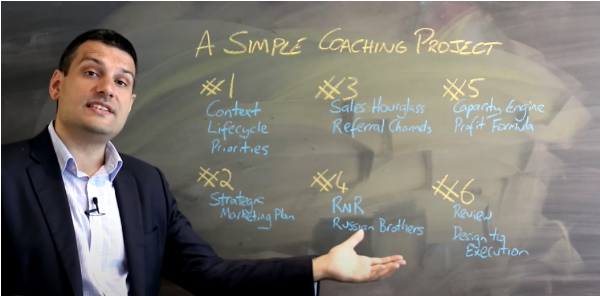A Simple Coaching Project. In Blackboard Fridays Episode 64, Jacob talks about Growth Planning. Need this implemented into your business? Talk to the international business advisor who can do exactly that – Contact Jacob, Learn More, or Subscribe for Updates.
Who is Jacob Aldridge, Business Coach?
“The smart and quirky advisor who gets sh!t done in business.”
Since April 2006, I’ve been an international business advisor providing bespoke solutions for privately-owned businesses with 12-96 employees.
At this stage you have proven your business model, but you’re struggling to turn aspirations into day-to-day reality. You are still responsible for all 28 areas of your business, but you don’t have the time or budget to hire 28 different experts.
You need 1 person you can trust who can show you how everything in your business is connected, and which areas to prioritise first.
That’s me.
Learn more here. Or Let’s chat.
Transcript
Hi Blackboarders, Welcome to Episode 64.
Having been publishing weekly for more than a year now, a question I’m often asked is “Where do I begin with the volume of content? How do I know exactly what my strategic priorities are?”
And it’s related to another common question I’m asked (I do love questions, so keep yours coming): “I think my business is ready for a good business coach, but where would they even start with me?”
So let’s answer both questions at once in this week’s episode: A Simple Business Coaching Project, or ‘How do I cover as much ground as possible without spending a fortune?’
Why Define a Simple Coaching Project?
Unquestionably, most of my clients want a bespoke solution starting with an in-depth Strategic Business Review. Smaller businesses, or those owners who need to take a smaller risk, may prefer Responsive Business Coaching – often with a narrow focus like “cash flow improvements” or “revenue growth”.
But when a small business owner is unsure about exactly what solutions they need, and I need to move quickly with both width and depth – that’s where this 6 coaching session project can be applied.
I can walk into any business and know that I’m going to create some positive outcomes by walking through the six coaching sessions that are detailed here.
And here’s the cool thing for Blackboard Fridays fans: this is also something that you could do yourself.
In fact, every single one of these topics has been covered in a Blackboard Fridays episode to help you to really make the most out of your business, wherever in the business lifecycle you are.
Coaching Conversation #1: Context and the Business Lifecycle
The first conversations you need to have, if you don’t really know where to begin on strategy, are around:
- The different Layers of Context, and
- The Business Lifecycle.
These topics are so important to business success that they were covered in the very first filming session of Blackboard Fridays.
The Layers of Context talks about how from your vision down, there are decision-making filters that impact us as business owners. We had great fun in Episode 41 where we explained this in a different way, diving deep “inside Ed’s head” to determine the number one priority for your business. In that video we did an exercise of marking yourself, compared to your business (not anyone else’s), across all the different elements and the different layers of context. This scorecard helped determine which questions were causing the most negative impact in your business, and therefore where you needed to start.
Now, use that information in conjunction with understanding the top three priorities for the phase of the business lifecycle that you are at.
So at the end of this coaching session you will have a list of up to a dozen different things that you could be focused on in your business; and you will have two frameworks (Layers of Context and Business Lifecycle phases) to help you to prioritize which 2-3 are going to be most impactful, that you need to address immediately.
Coaching Conversation #2: Strategic Marketing Plan
That first session might be sufficient for you to go and build a business plan. If you do want to keep going though, the next step we have is looking at your:
[Edit 2024: Additional research in the years since this video was filmed has led to the evolution of this framework and its deeper integration with other business tools. This is now known as the Como Revenue Flow Framework – you can learn more in one of my recent Business Mastery training videos online here.]
In the linked Blackboard Fridays episode we talked about identifying your ideal clients, we talked about understanding their pain, and we talked about defining your brand promise so that it matches the pain of your ideal client.
You demonstrate that you are their solution. Then, you use the Five Attractants to convert those ideal clients into leads at the top of your sales hourglass.
I have a lot of value with clients running that exercise in a coaching session!
Coaching Conversation #3: Sales and Strategic Referrals
The next step, which won’t surprise you after we talk about generating leads, is how we then get into the Sales Hourglass and turn those leads into paying clients.
- Introducing the Sales Hourglass
- The Benefits of Strategic Referral Channels
Looking at the Sales Hourglass you can measure your current conversion rate – as those leads move down through a Brand Promise, Engagement, perhaps a Commitment Product, how well do you do percentage-wise in converting each lead into an engagement … and into an actual client?

As we talk Sales and conversion rates, you can start to see how we shift from the inspiration of these episodes into something practical that you can do.
If your conversion rate is currently 30% and you want it to be 50%, what can you do about that? What else can you do at each of those different layers of the hourglass differently to improve your outcomes?
This is also a great time (since it’s the bottom part of the Hourglass, best place to expand your relationships into future revenue) to look at your Strategic Referral Channels, How successfully are you building those relationships so you have an unpaid salesforce out in the marketplace sending you pre-qualified, pre-sold leads?
Because done well, that will have a massive impact on your conversion rate!
Coaching Conversation #4: Turn More Money into More Time
We shift now from the revenue coming in, to start looking at your profitability and your efficiency – how well are you investing money and time using the R&R framework: Clear Roles ‘n’ Responsibilities to create Rest ‘n’ Recuperation?
- The Operational Structure section of the Complete Blackboard Fridays website outlines all the key exercises summarised below
The exercise you can run for yourself as a small business owner:
- Where are you spending your time today across the four categories of Wealth, Growth, Revenue, and Administration?
- What percentage is your current mix and how would you like to be spending your time?

And then use the Russian Brothers exercise to design that shift. If you want to be doing more Growth, more Green time, then what specifically will you do “Morov”? And more importantly, to create that time, there’s probably some Red, some Admin that you need to be doing “Lessov”? What are the specific tasks that you need to shuffle in order to have the right balance of your investment of time in the business?
Of course if you have a larger business and a team, then undertake the full RNR project, going through things like roles and responsibilities charts, ideal weeks, momentum meetings, workflows, training, all of those aspects are critical to improving the efficiency and profitability of your business.
Coaching Conversation #5: A Growth Plan Your Team Can Understand
Once we start talking dollars, it’s hard to escape them and so session 5 is now building out the growth plan using:
- The Capacity Engine framework to map your journey from now to where you want to be, and
- A reviewed Profit Formula to grow with positive cash flow
We learned through the Capacity Engine that, strategically, there’s only one decision you need to make in your business at any point in time. Do I need to “Be Better“, get more power out of my current engine, or do I need to “Be Bigger” and grow the size of my engine?
It’s taking those steps towards the vision that you defined in Coaching Session #1 that helps build the strategy of your capacity engine.
Which is also a timely reminder to review your Profit Formula and to make sure that as you grow, you continue to do so in a profitable manner.
Coaching Conversation #6: Design for Execution
The last of the six sessions that I recommend is an iterative review.
You’ve covered an awful lot in your business going through this program, so take the time to review what you learned, what you decided to do differently, perhaps even some of the quick wins you’ve already achieved, but then take all of the different things you could be doing and actually turn them into a strategic design.
You can’t do everything at once. Good strategy is knowing what you’re saying “no” to or at the very least “not yet”.
With this focus, you can then choose what you’re going to focus on strategically and then shift from that design to execution because ultimately, no matter how good the frameworks, no matter how good the Blackboard Friday videos you watch to help you do that, or the coach that you engage to walk you through this and ask you those tough questions, no matter how good all of that those ideas are worthless if you don’t execute.
Wherever you are in your strategic journey, of course my team and I would love to help you go through this process – or something more specific, if you do have a clear specific need.
If this strategic approach is something that you want to trial yourself – well, that’s why we’ve created all these free videos and tools, to help you:
- Understand all of these critical conversations
- Recognise the decisions you’ve made in the past … and the decisions you need to make in the future
- And have a clear plan you can communicate and implement, in order to achieve the business dream that you’ve always desired.
Next Steps
Want to learn more about how this can apply to your business? It costs nothing to chat:
- Email me jacob@jacobaldridge.com (I read them all)
- Call, Text, or WhatsApp me +61 427 151 181
- Or just Subscribe https://jacobaldridge.com/about/subscribe-to-jacob-aldridge-com/ to stay in touch




